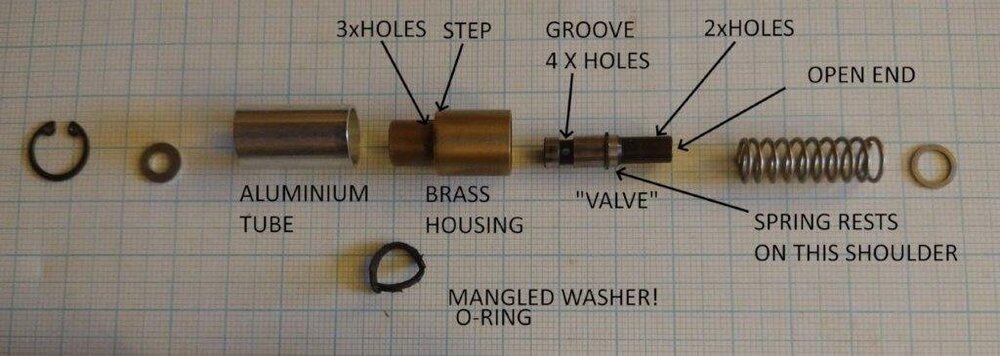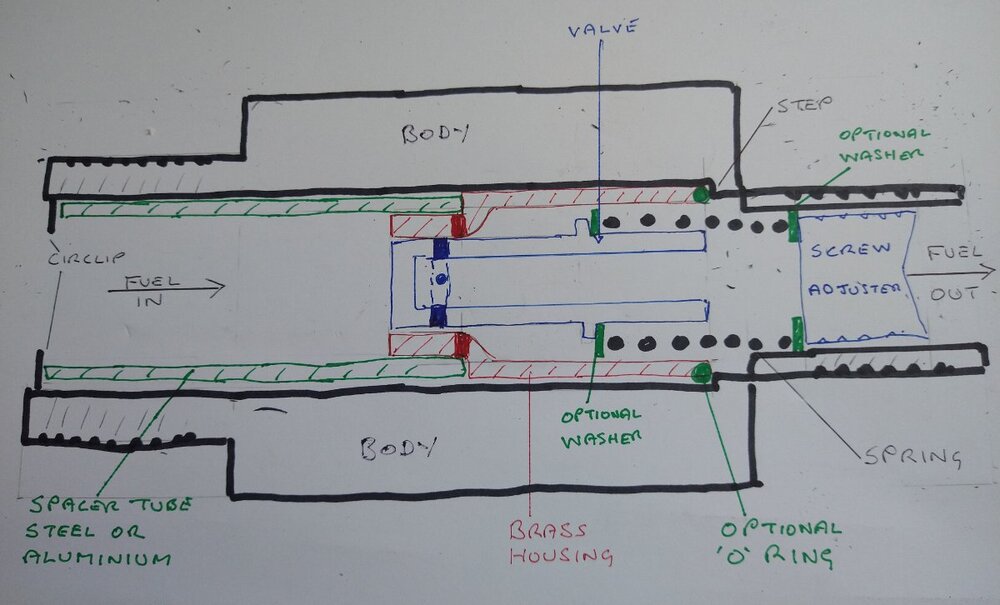
JCP
-
Content Count
11 -
Joined
-
Last visited
Content Type
Profiles
Forums
Calendar
Posts posted by JCP
-
-
-
Following on from my earlier posts I think that I have now resolved the assembly and operation of the Lucas PRV and I attach a rough schematic diagram of how it goes together.
Working from the input end, the spacer tube buts up against the brass body (red) and locks it against the step inside the main body of the PRV so that, when held in place by the circlip, no movement is possible. I suspect that the spacer tube is a necessary addition in the change from short to long-body PRVs. I also suspect that the original Lucas PRV uses a steel tube (as Waldi's), but the aftermarket versions use aluminium.
The operation of the PRV is as suggested in my earlier post: pump pressure operates on the top of the valve and when this exceeds the opposing pressure of the spring/adjuster, it moves down to allow the 4 radial holes in the brass body to line up with the groove and holes in the valve, allowing excess fuel to escape down the centre of the valve and thence back to the tank.
My aftermarket PRV has 3 “optional” components not seen in all versions:
- a small washer between the nylon adjuster and the base of the spring to spread the load.
- a washer against the shoulder of the valve to provide positive location of the top end of the spring.
- and the mysterious O ring! There will obviously be some leakage between the brass body and the bore of the main body of the PRV and the purpose of the O ring is to block this leakage. It is not present in all PRVs and it is either there as a modern "improvement ", or to compensate for the lower machining/assembly tolerances of the aftermarket PRVs. In either case, it is not a very satisfactory solution as it is trapped on a narrow lip against the narrow circumference of the brass body under very high pump pressure - hence the failure.
Apologies for the long post. John P
-
John. Thanks. The issue becomes clearer. John P
-
Waldi - good thought, but I suspect we will never know! If i find an answer i will post it. Thanks for your contribution, and I hope my new PRV will cure the problem. John P
-
Thanks Waldi. Like you I have the Dowty seals between the main body sections, but the mangled rubber O ring definitely came from inside the PRV; whether it should be there, or where it came from, is a mystery! John
-
Thanks John. My CP was restored before i bought it, so i don't know the origin of the PRV, but the rubber O ring definitely was inside it - although whether it should have been there is another question! The PRV was definitely new, so perhaps it was configured to work with the Bosch set-up? I will probably send it away to Prestige to have it refurbished as a spare. John P
-
 Because of erratic pressure with my Bosch system, I replaced the Lucas-style PRV with a diaphragm type. Wishing to see if the original PRV had any problems I dismantled it. Despite much research, I have been unable to find a component diagram for the Lucas PRV, but this is what came out of mine; note the mangled O ring - where did it fit? Other than the obvious components, the important parts are:
Because of erratic pressure with my Bosch system, I replaced the Lucas-style PRV with a diaphragm type. Wishing to see if the original PRV had any problems I dismantled it. Despite much research, I have been unable to find a component diagram for the Lucas PRV, but this is what came out of mine; note the mangled O ring - where did it fit? Other than the obvious components, the important parts are:
The brass housing. This has 3 small radial holes just above the "step".
The inner "valve". This is a tube, open at the spring end, with an annular groove near the top with 4 opposed holes, and 2 further holes near the spring end. The spring bears on a shoulder on the valve, forcing it on a seat in the brass housing; this in turn pushes on the brass housing - and the aluminium spacer.
The O ring would fit best between the aluminium sleeve and the step in the brass housing - but this would partially block the 3 radial holes.
I have been trying to fathom out how the system works. My best guess is that:
- fuel under pressure enters the aluminium spacer.
- when the pressure exceeds the force of the spring, the valve depresses until the annular groove is level with the 3 holes in the brass housing and fuel can pass into the centre of the valve and thence into the overspill.
But why does the brass housing not move as it is held in place by the same spring?
And where does the O ring fit?
-
Hi Waldi. My name is John. I am putting together a contribution to the thread forwarded by Stuart (thanks Stuart) to compare my PRV to yours.
-
Thanks Stuart but (unless I am going blind!)the Red Book does not appear to have a diagram of the internal components of the PRV.
-
Does anyone have a component diagram of the Lucas PRV? I dismantled mine and discovered a mangled O ring! Thanks in advance.


Headlight switch set up without the foot-operated dip switch?
in TR6 Forum
Posted